Today, I’m sharing possibly the most classic Indian dish ever: Dal Tadka!
I grew up eating dal nearly everyday as a child (like many Indian kids!), and this version is my favorite weeknight dal recipe. It’s creamy, packed with layer upon layer of flavor, and is a warm hug in a bowl. It gets taken over the top with the spiced oil (tadka) and tastes like pure comfort food (but is healthy, vegan, and gluten-free).
And if you have my cookbook, The Vegan Instant Pot Cookbook, you can find a recipe for an easy but delicious Dal Tadka in Chapter 3.
What is Dal Tadka?
Dal = the Hindi word for lentil.
In India, dal refers not only to the dish but also to lentils themselves. The dish is basically a deeply spiced, aromatic lentil stew, but there are countless regional variations of dal and even more variations across each Indian family.
Tadka = tempered oil in which spices, herbs, and/or aromatics are briefly fried in oil. The name differs depending on the regional language. For instance, in Gujarati (the language my family speaks), we call it vaghar.
The dal (lentils cooked in spices and aromatics) is finished by pouring the tadka on top.
In this recipe, split lentils are cooked in a mixture of aromatics, ground spices, and tomatoes (which bring a pleasant tanginess) until soft and creamy. The lentils are finished with the fragrant tadka, which enhances both the taste and texture.
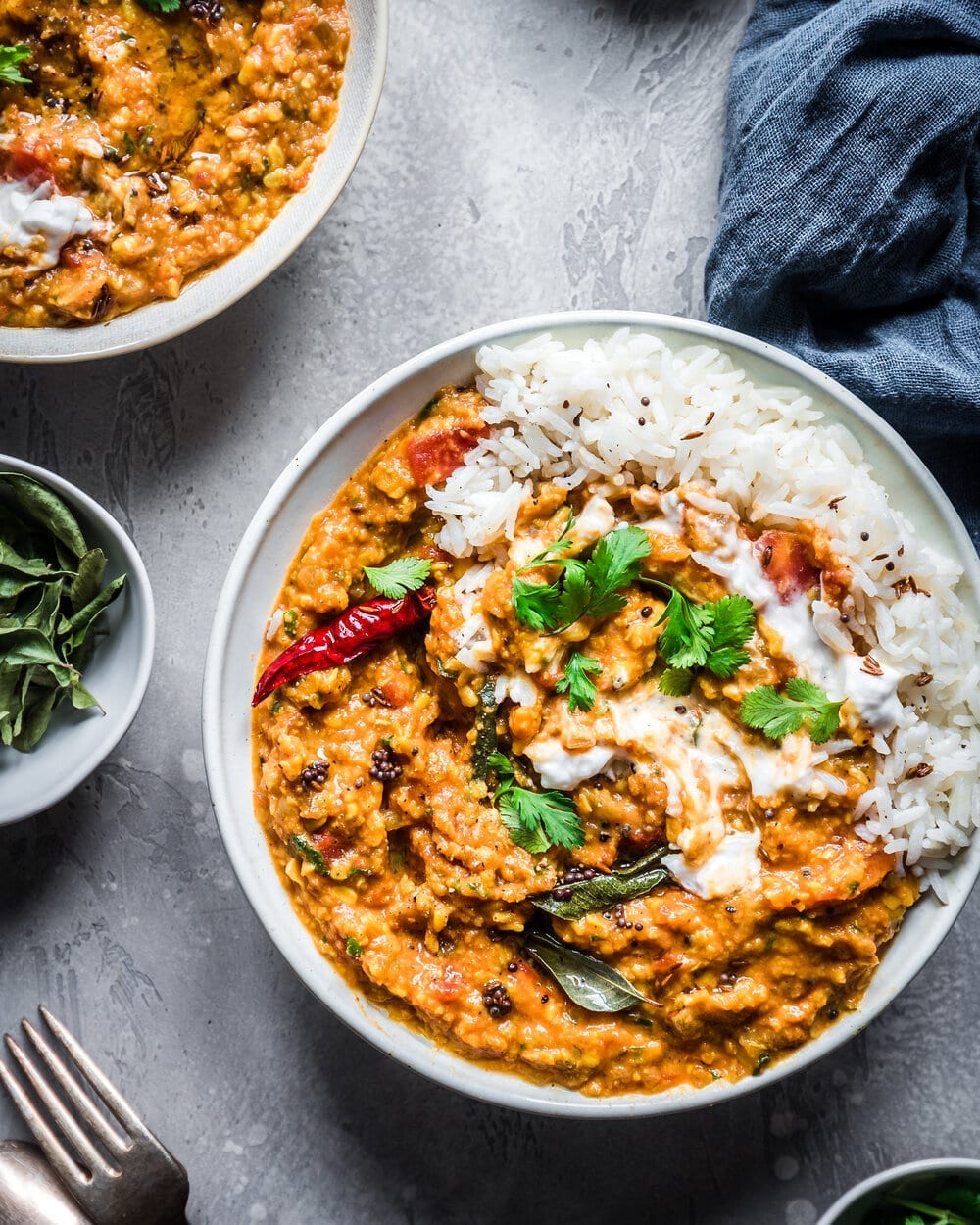
Why you’ll love this Dal Tadka
Pantry staples. Aside from a few aromatics (fresh ginger, green chili pepper, and cilantro), this is a pantry recipe!
Budget-friendly. In addition to being a pantry meal, it’s budget-friendly!
Authentic Indian food, restaurant-style. There are a ton of Indian recipes out on the internet, and a lot of them skimp on spices or just use one or two bottled spices. I can see the appeal of that, but if you want a truly authentic (and incredibly delicious) Indian dal, this is the recipe for you!
Comfort food but healthy. It’s creamy, deeply spiced and aromatic, and tastes indulgent. BUT, it’s made with wholesome ingredients and high in protein, thanks to lentils. Dairy-free, gluten-free, soy-free, and nut-free, so it’s allergen-friendly too!
What kind of lentils are used in dal?
Dal is typically made with split lentils or split peas, but there are also variations that use split chickpeas (“chana dal”) or kidney beans (“rajma dal”).
In this recipe, I use moong dal (AKA yellow split lentils), but growing up, my mom most often used toor dal (AKA yellow split pigeon peas). You can easily substitute with other split lentils. The cook time will vary, with the chana dal likely taking the longest, so you need to keep an eye on the dal as it cooks.
You can find every variety of split lentil and pea at South Asian grocery stores. If you have access to only a basic grocery store, use regular red lentils (they will take a bit longer to cook since their skins aren’t split).
You can also find these lentils on Amazon. All of these varieties work in this recipe.
- Moong Dal (yellow split lentils)
- Toor Dal (yellow split pigeon peas)
- Chana Dal (split chickpeas)
- Masoor Dal (red split lentils)
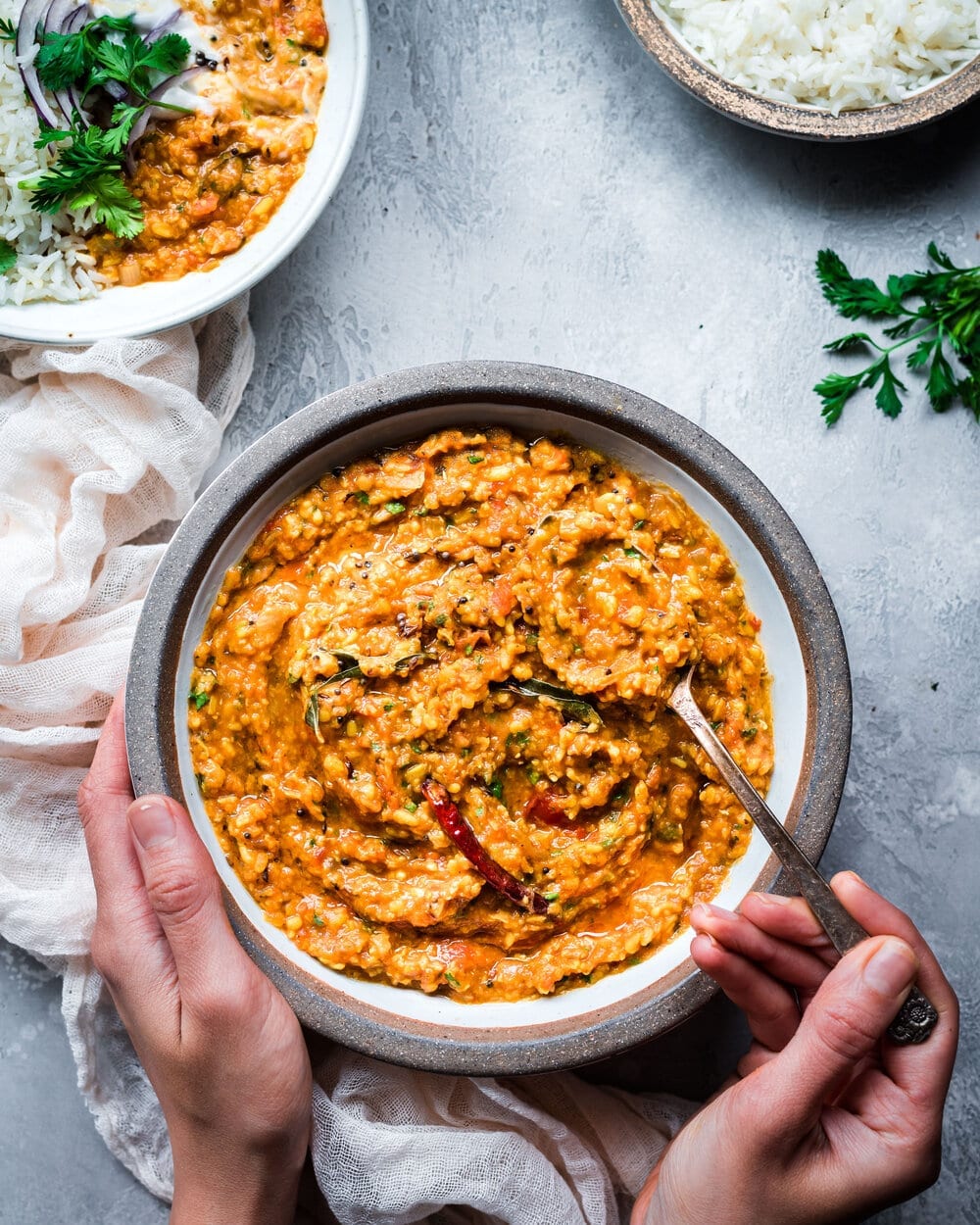
Everything you need to know about Tadka
Tadka is tempered and spice-infused oil, widely used in Indian cooking. The idea is to toast spices and aromatics in a fat source, as it releases their essential oils, which is where the aroma and flavors live.
Basic instructions for tadka
Heat up a few spoons of oil in a small pan (sometimes ghee is used, but I use oil to keep it vegan). Add whole spices and/or sliced or minced aromatics (like ginger or garlic). Toast them until they sizzle and become aromatic, swirling often to prevent burning.
If adding ground spices, add them last, for just 10-30 seconds. Stir or swirl the pan frequently to prevent burning.
Tip: The tadka brings SO much flavor and warmth to the dish (and even texture). It takes the dal from good to fantastic, so please please please don’t skip it!!
Tips for making tadka
An Indian spice tin is very handy. When you have to work quickly, it’s convenient to have all the spices in shallow, uncovered tins rather than in individual deep spice jars.
A small skillet works best, but a tadka pan is even better! It’s a tiny, deep saucepan that looks like a ladle and helps prevent the spices from jumping out of the pan.
Once your spices have released their fabulous aromas, take them off the heat immediately to prevent them from overcooking or burning.
What spices are used in tadka?
My version contains black mustard seeds, cumin seeds, curry leaves, and dried red chili pepper. I think the curry leaves and mustard seeds add the most flavor, so I wouldn’t skip those if you have an Indian grocery store near you. If you don’t, here are some dried curry leaves on Amazon.
Substitutes: If you don’t have all the spices in this recipe, fret not because every tadka is different. Here are some substitute options.
- Thinly sliced shallots or garlic
- Fennel seeds or fenugreek leaves
- Whole cinnamon sticks, broken into pieces
- Whole cardamom pods or whole cloves
- A few pinches of ground spices, such as cumin or coriander (be sure to add for just a few seconds at the very end to prevent burning)
- Asafoetida powder (aka hing) is often added to dal, as it helps the body better digest legumes. It brings all the spices together and makes it taste distinctly Indian. Note: it smells very pungent and offputting, but once cooked, its odor disappears.
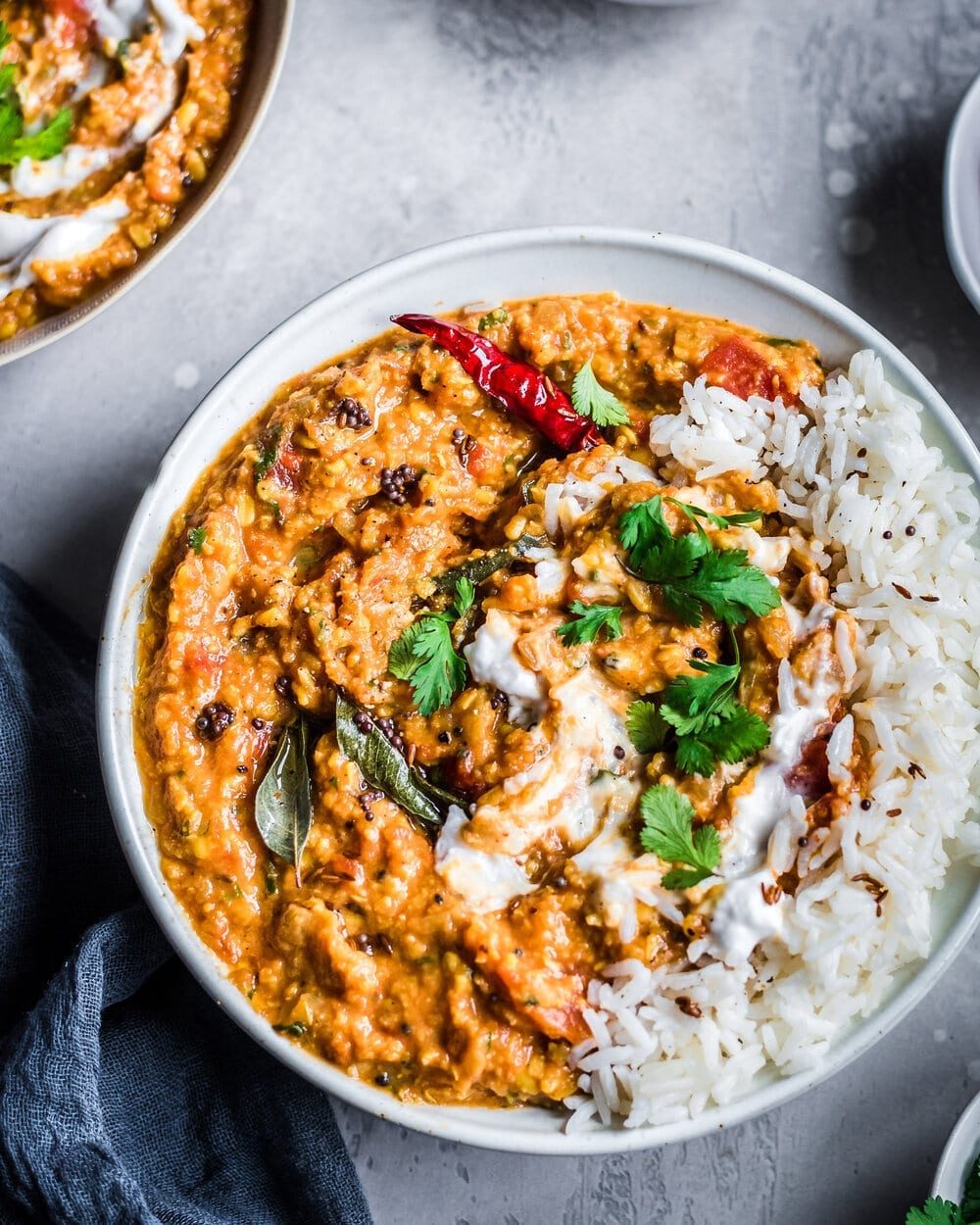
How to make Dal Tadka (step-by-step instructions)
Gather your ingredients.
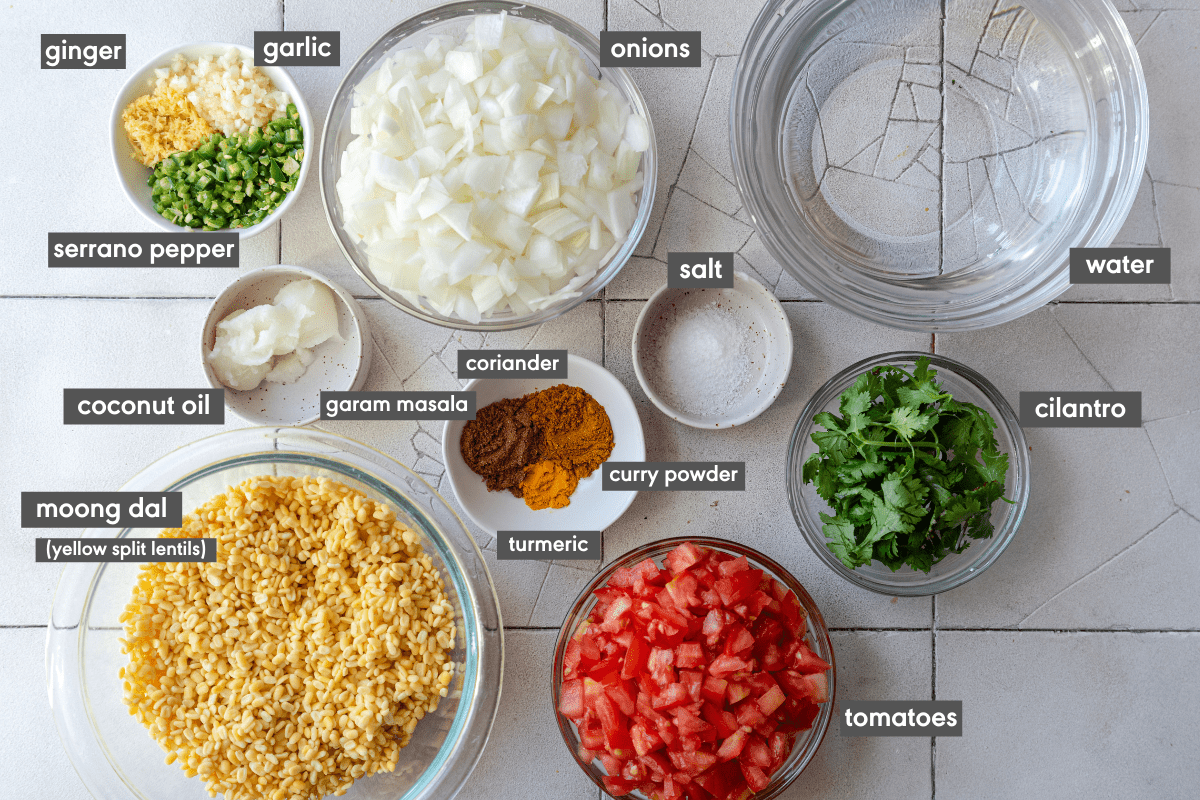
Heat a large frying pan over medium-high heat with the oil. Sauté the onions until starting to turn golden. Add the garlic, ginger and serrano pepper, and sauté for 60-90 seconds.
Add the ground spices and stir almost constantly for 30 seconds. Pour in 2 cups water to deglaze the pan, scraping up the browned bits.
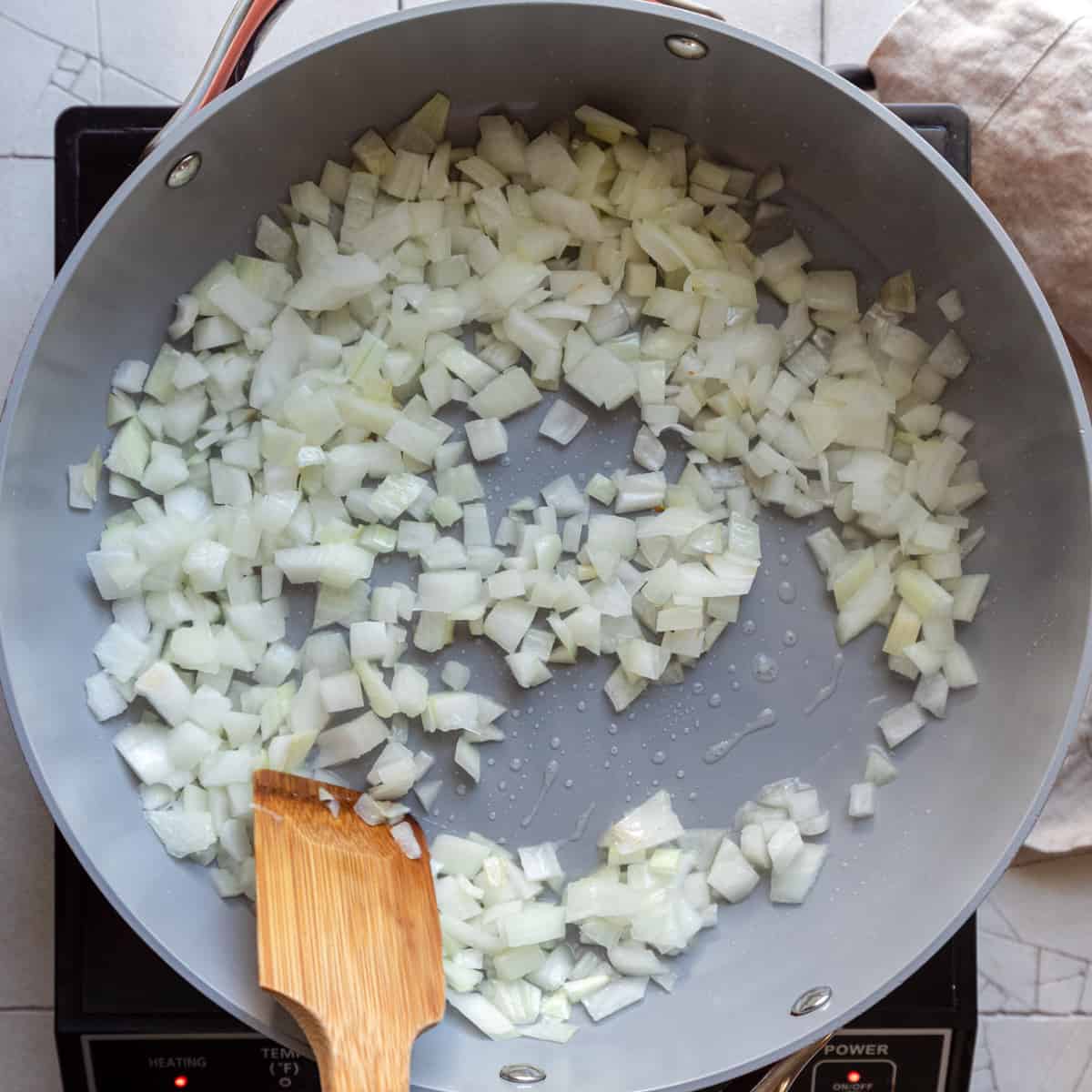
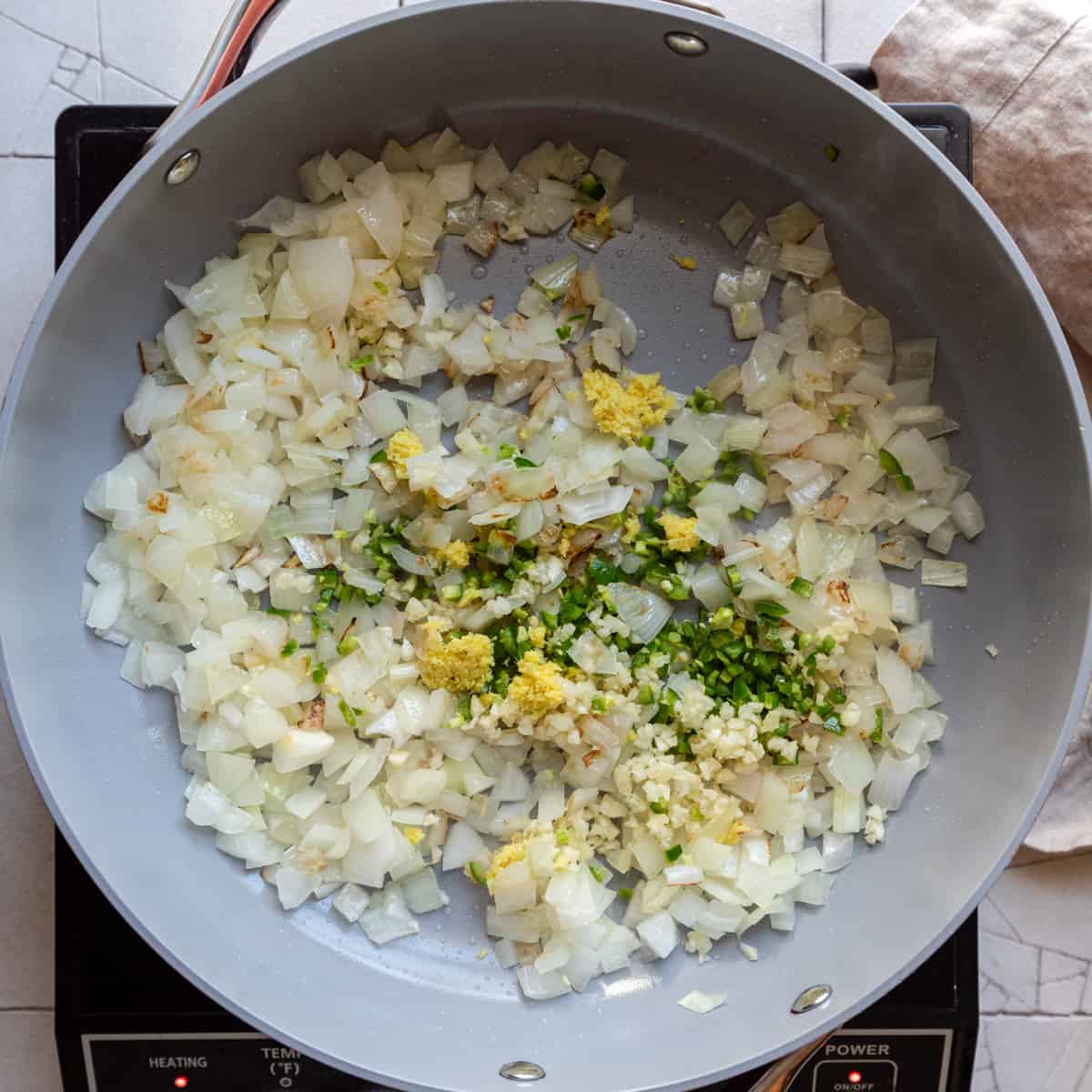
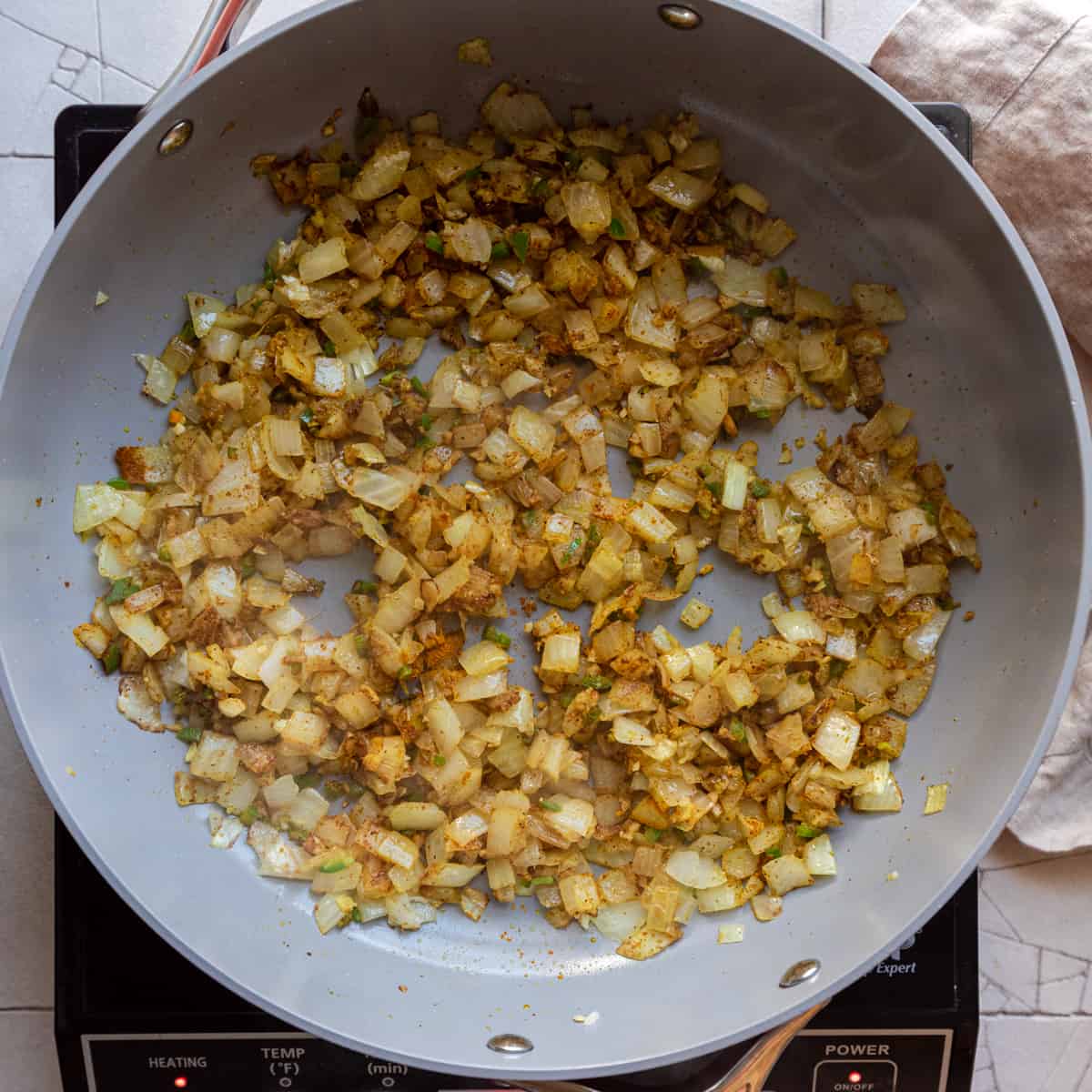
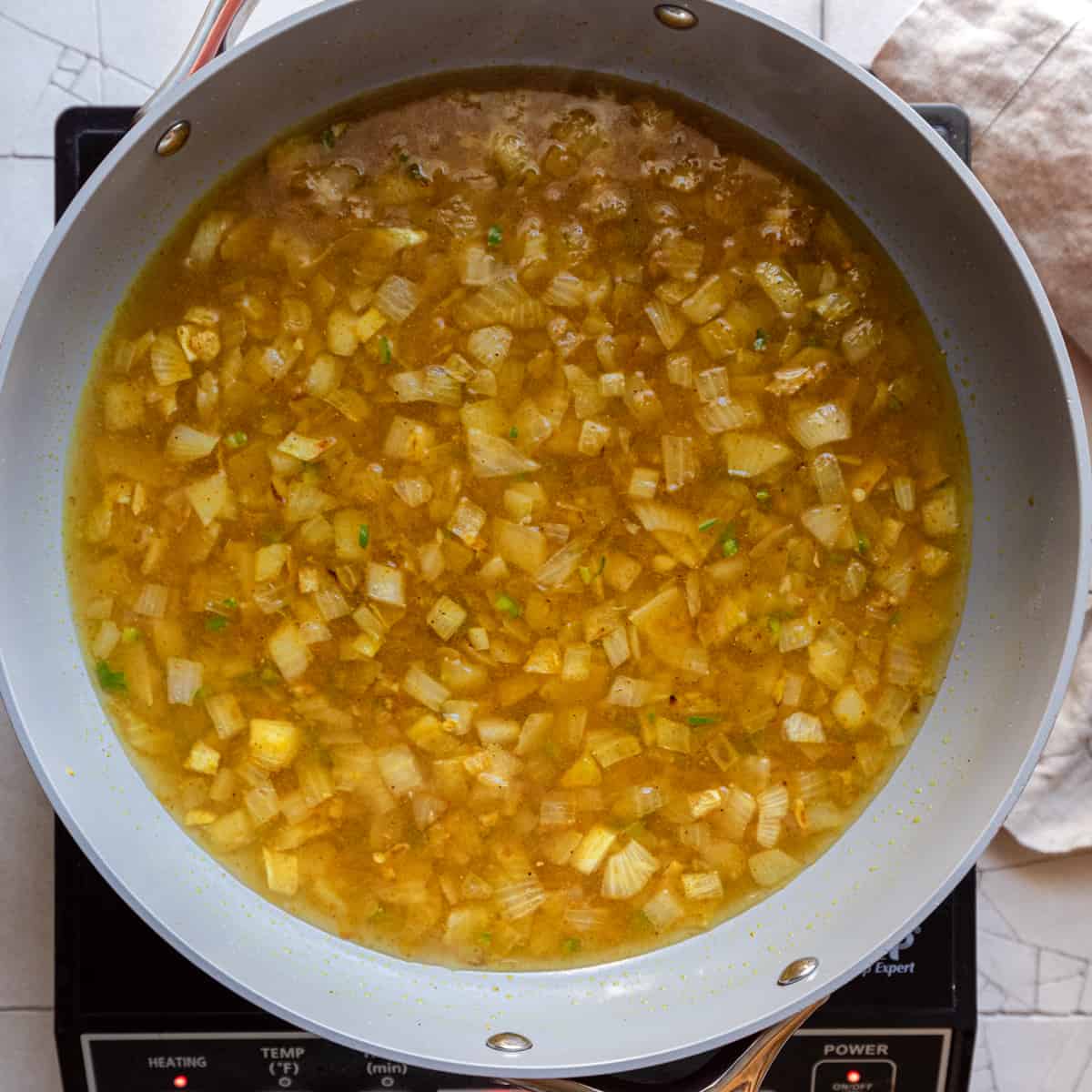
Add the lentils and salt/pepper to the pan. Bring the dal to a boil, then partially cover the pan and reduce the heat to maintain a simmer. Simmer for 30 minutes.
Add the diced tomatoes, stir, and cook uncovered for 4 to 5 minutes, until tomatoes are broken down (fresh tomatoes need more time). At the end, stir in the chopped cilantro.
Tip: for a creamier texture, run an immersion blender through some (but not all) of the dal.
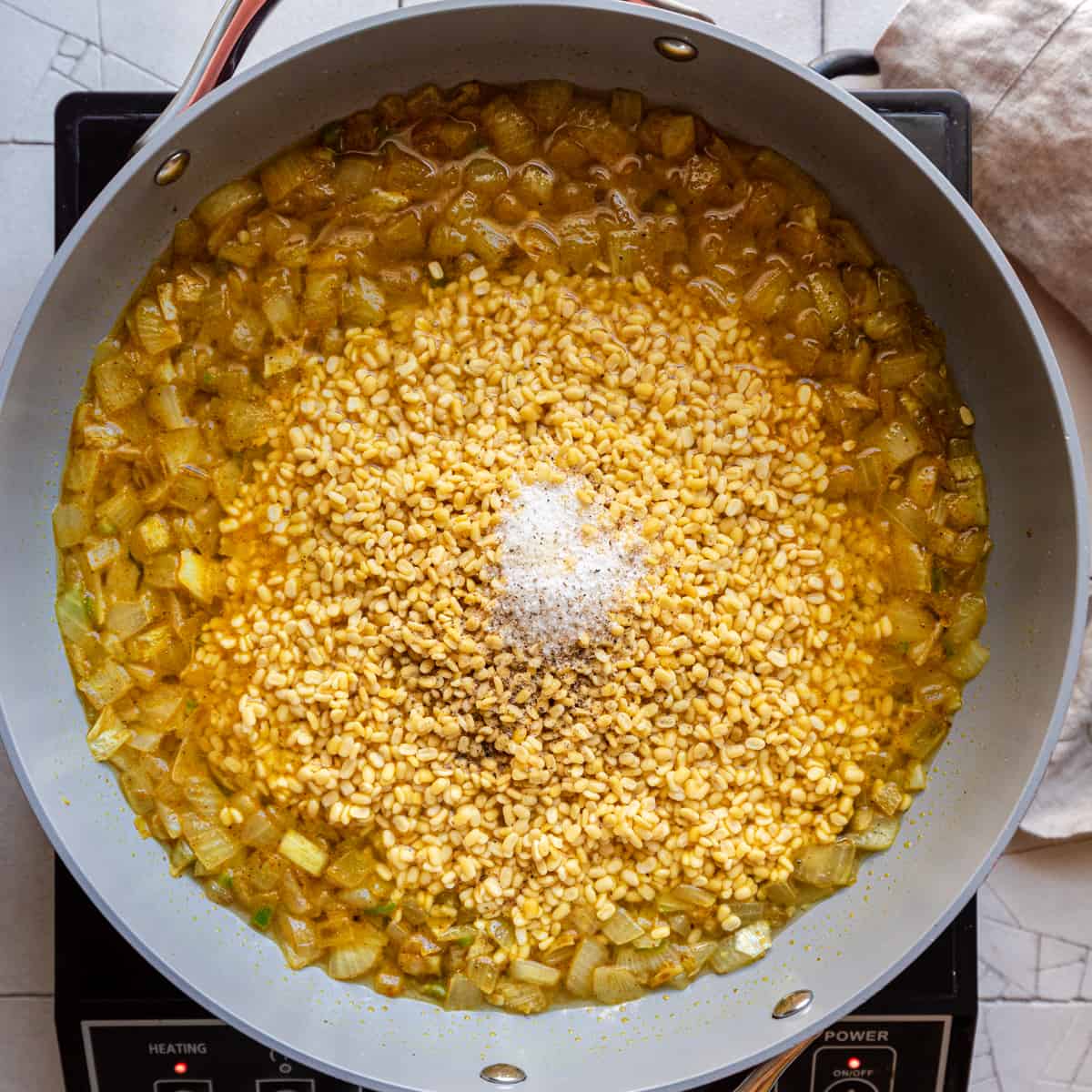
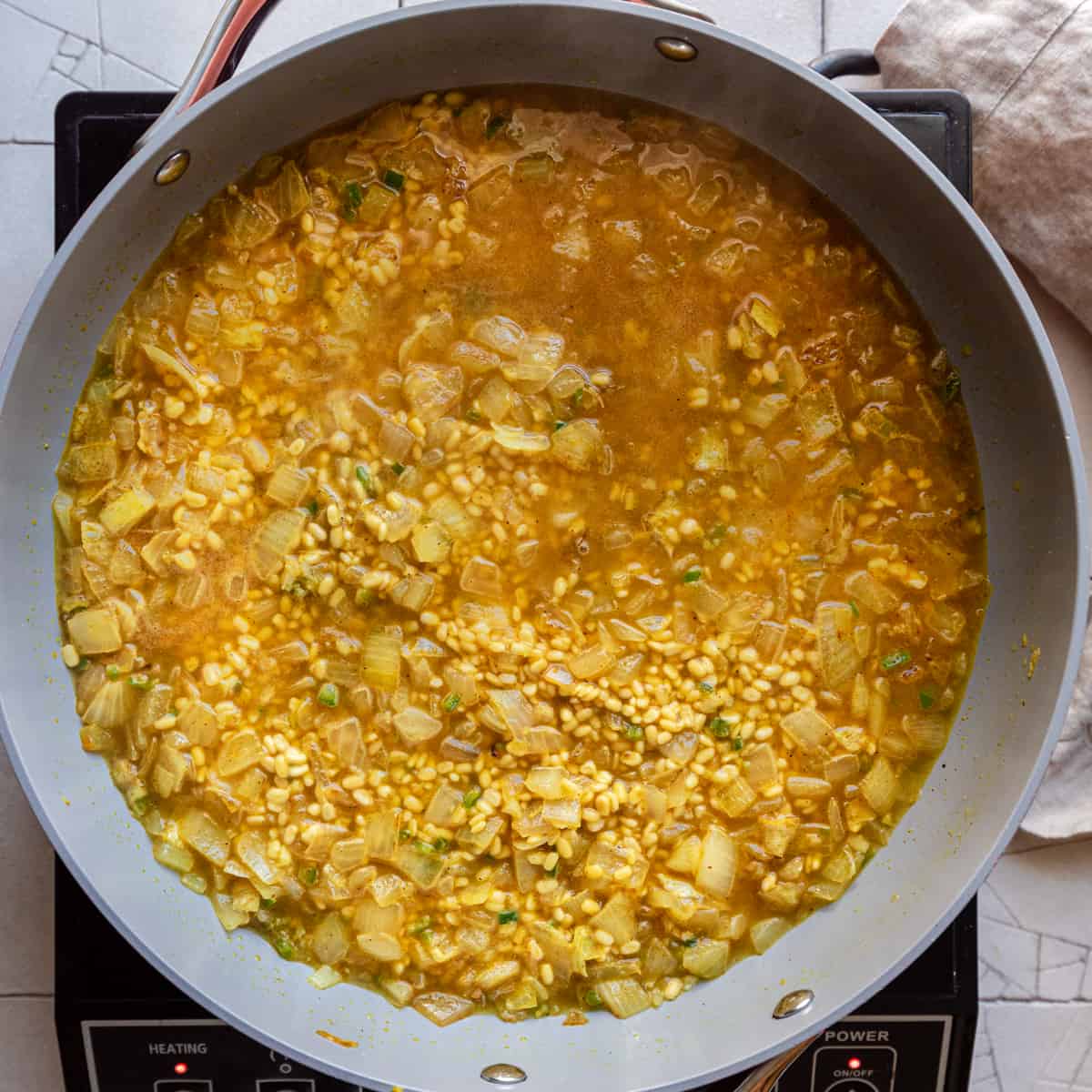
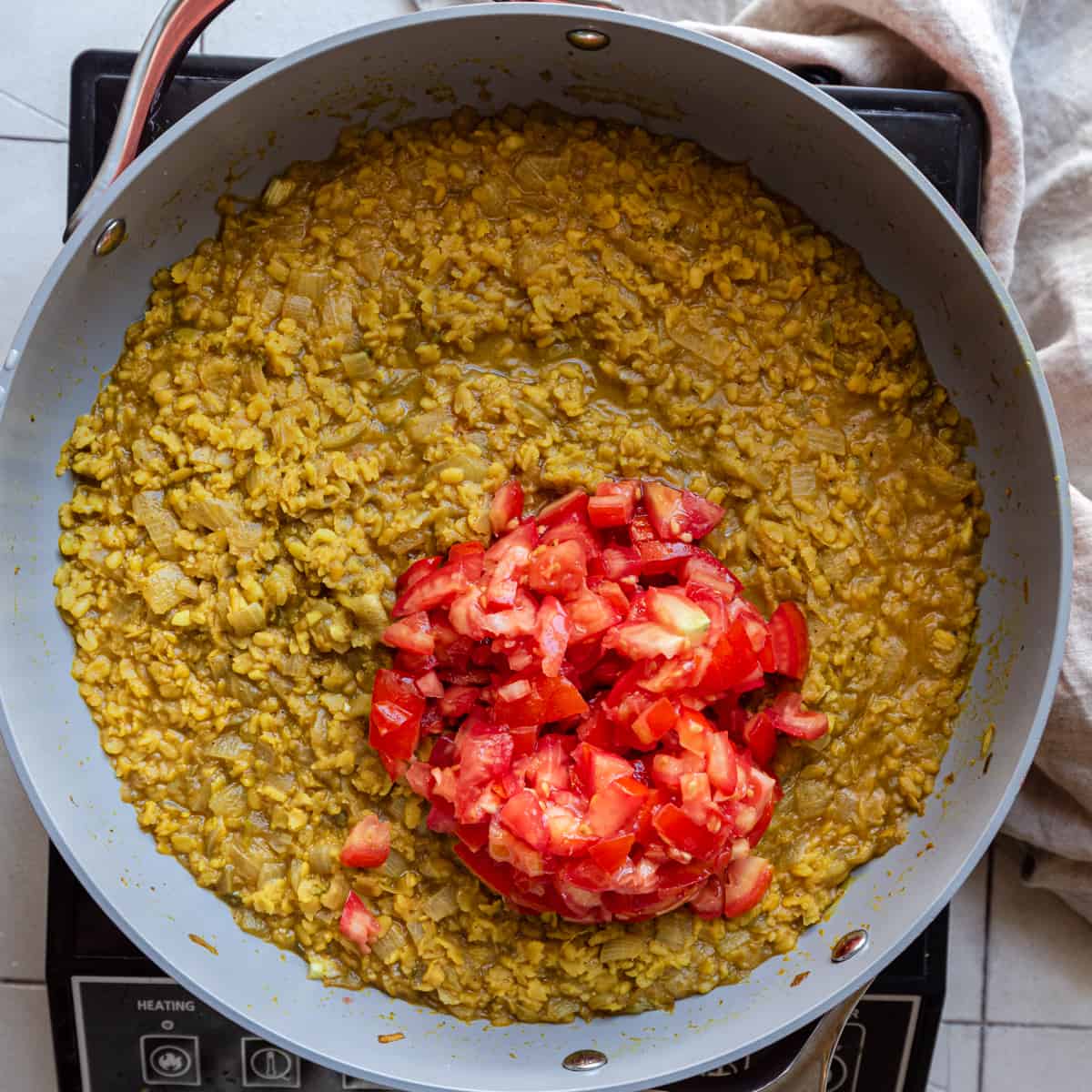
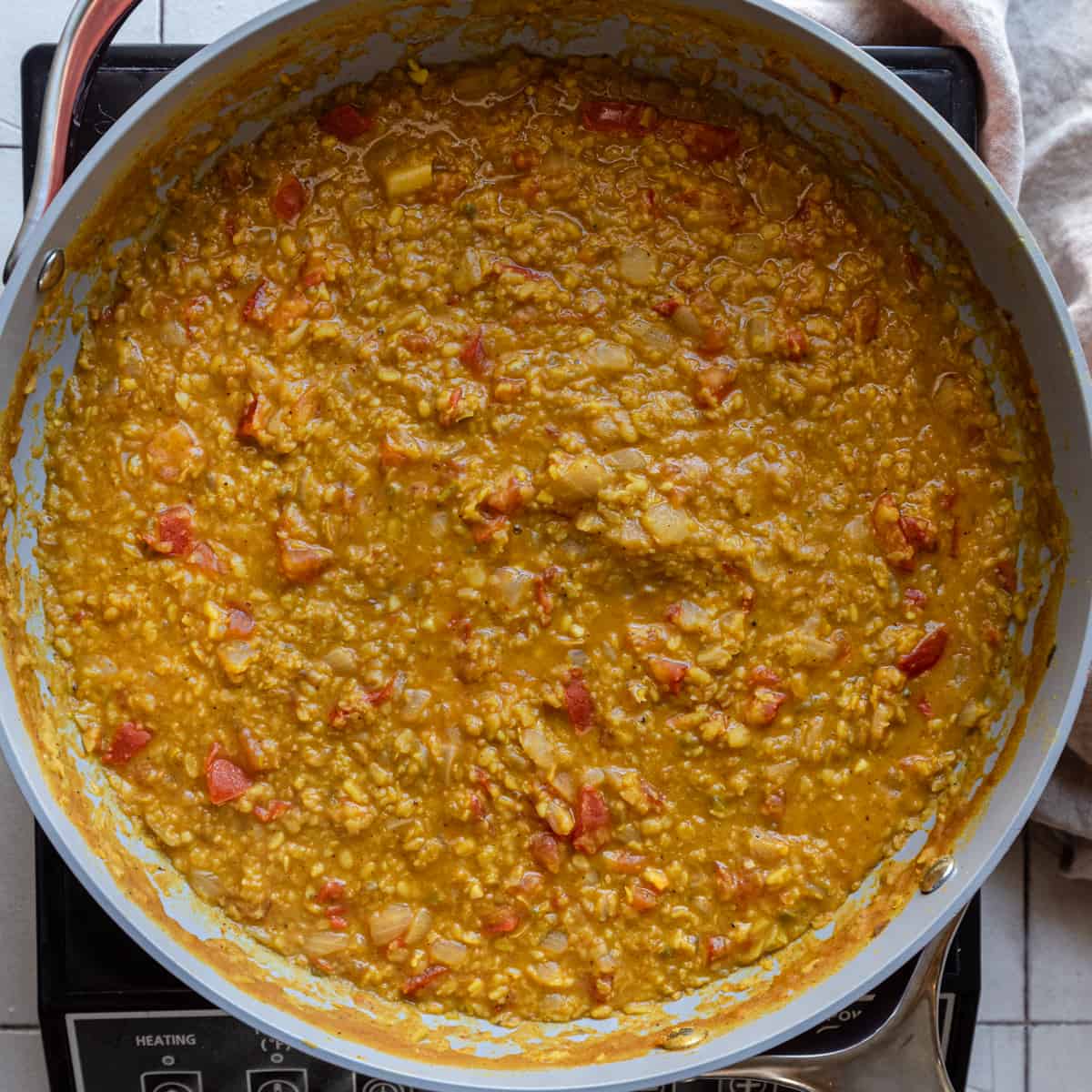
Before serving, make the tadka. Heat a couple spoons of oil up in a tadka pan or small skillet. Once shimmering, add the mustard seeds. Once they pop, add the cumin seeds. Finally, add the curry leaves and dried red chile peppers.
Keep stirring or shaking/swirling the pan to help cook the spices evenly and to prevent burning, for a total of 60-90 seconds.
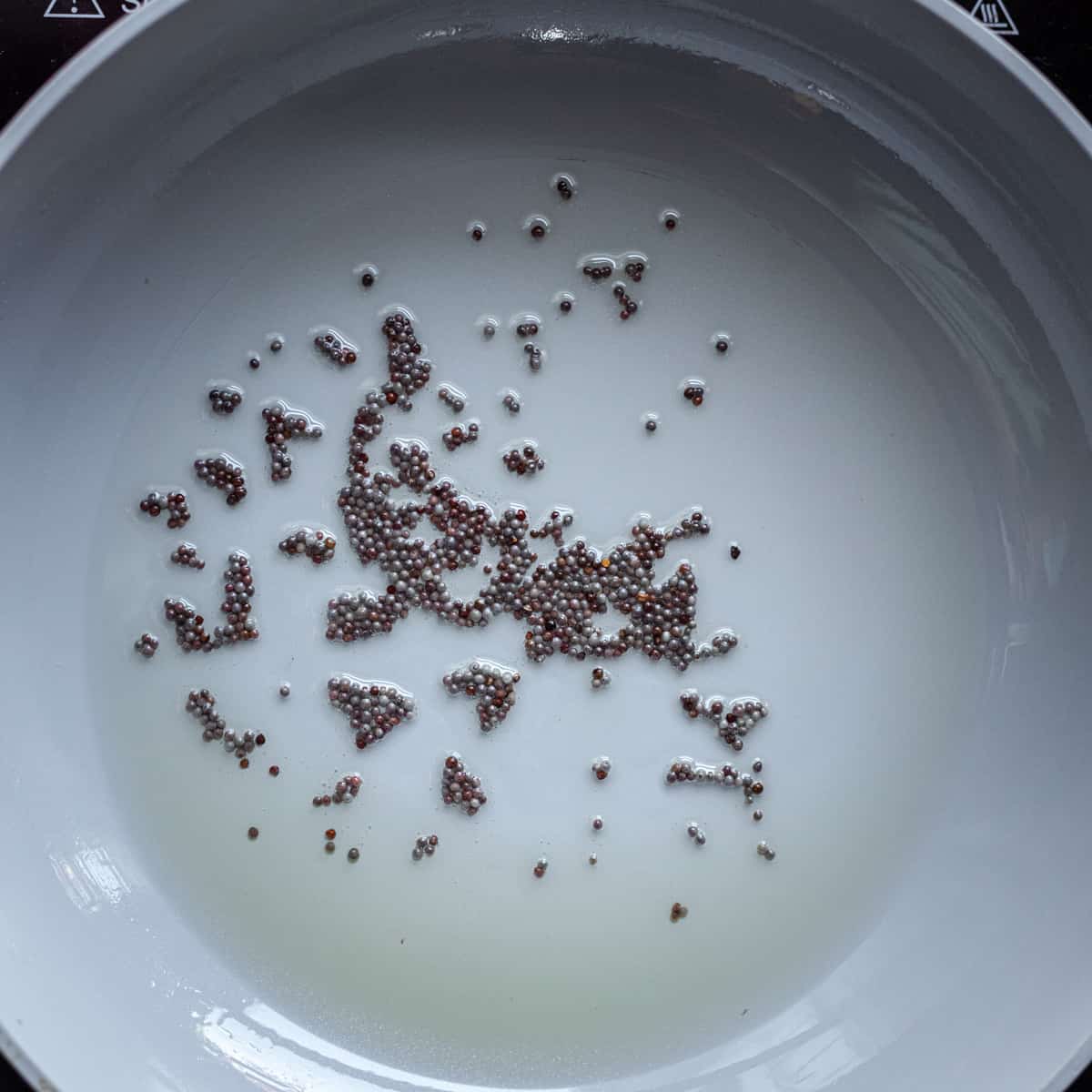
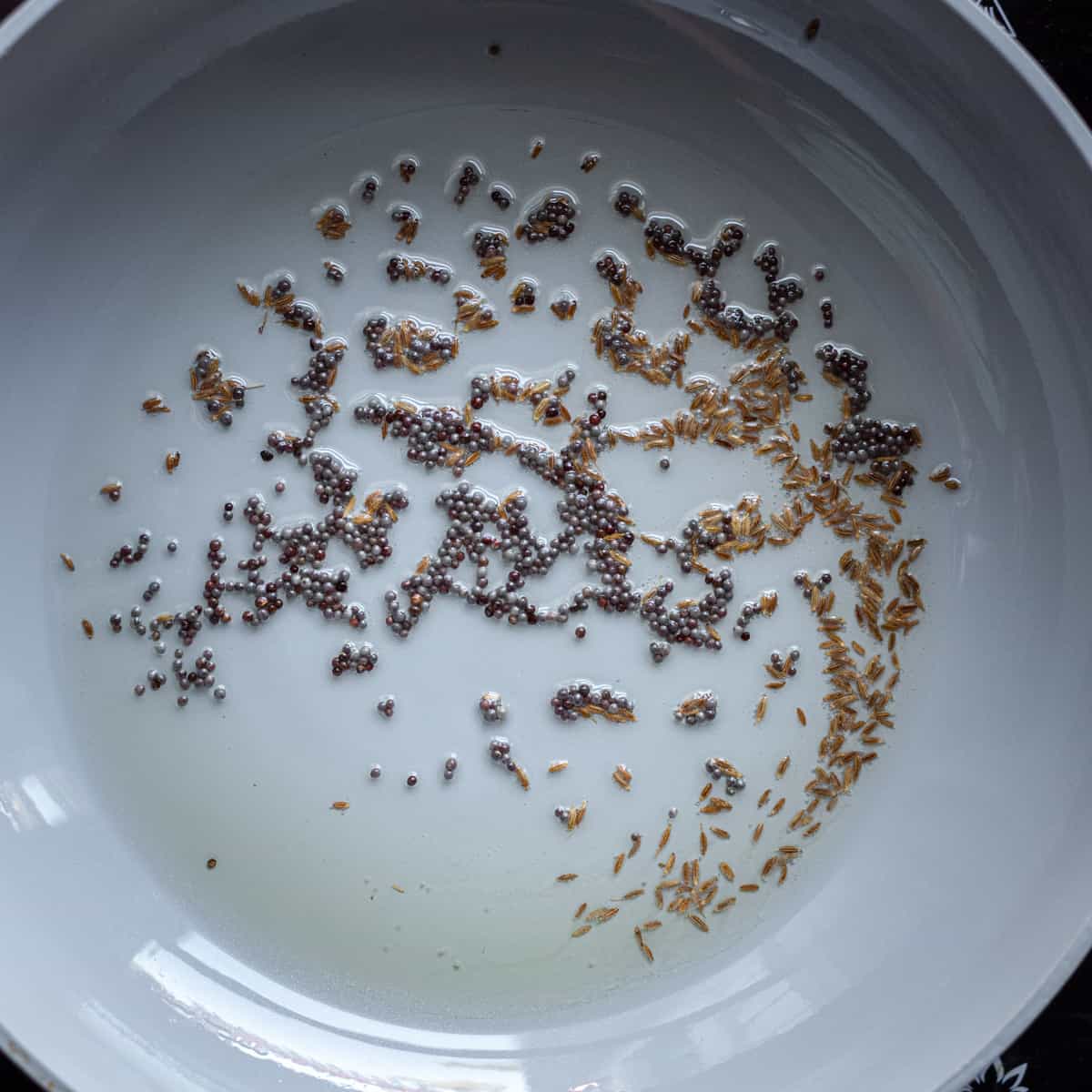
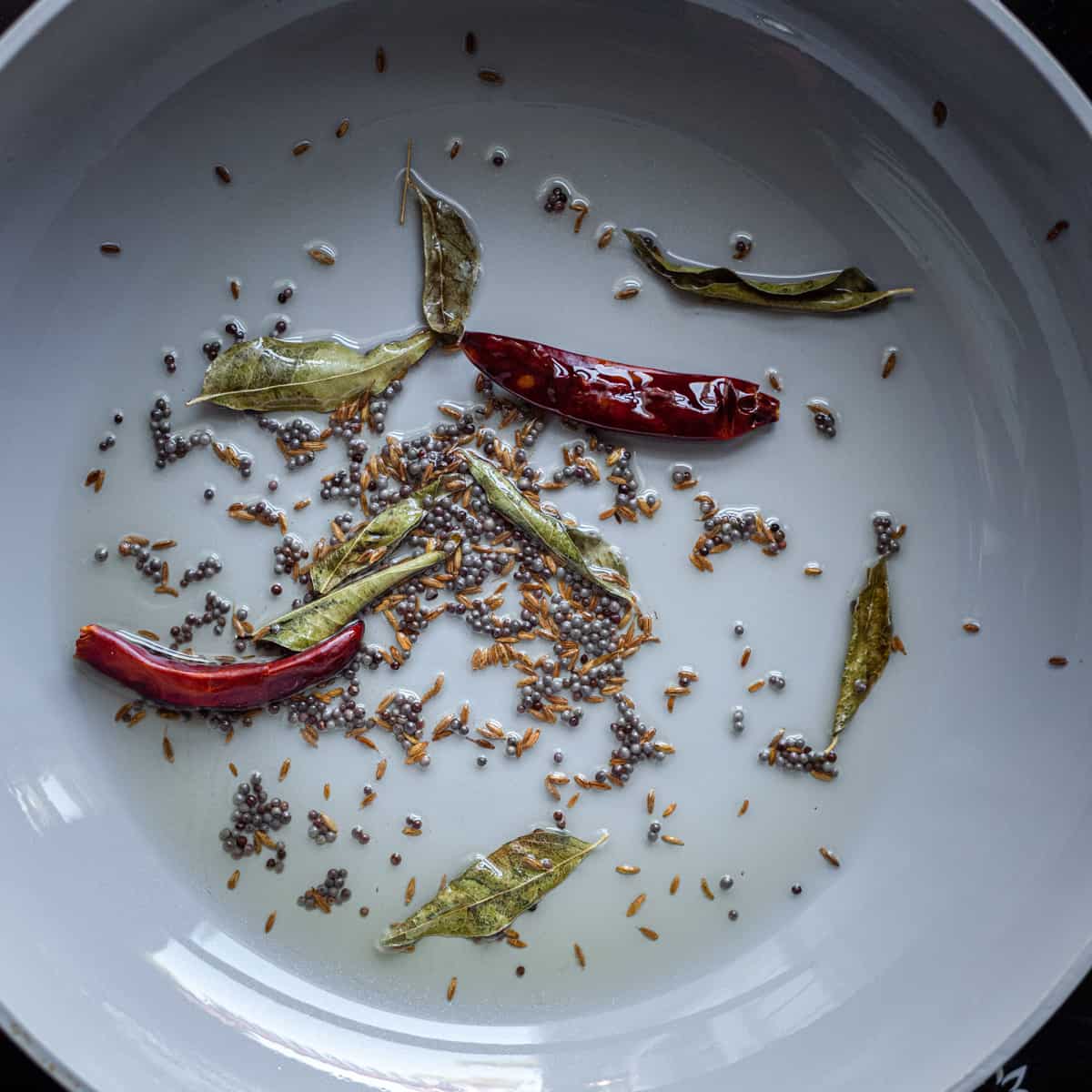
Pour the tadka over the dal and stir to incorporate. Garnish with more cilantro and serve warm!
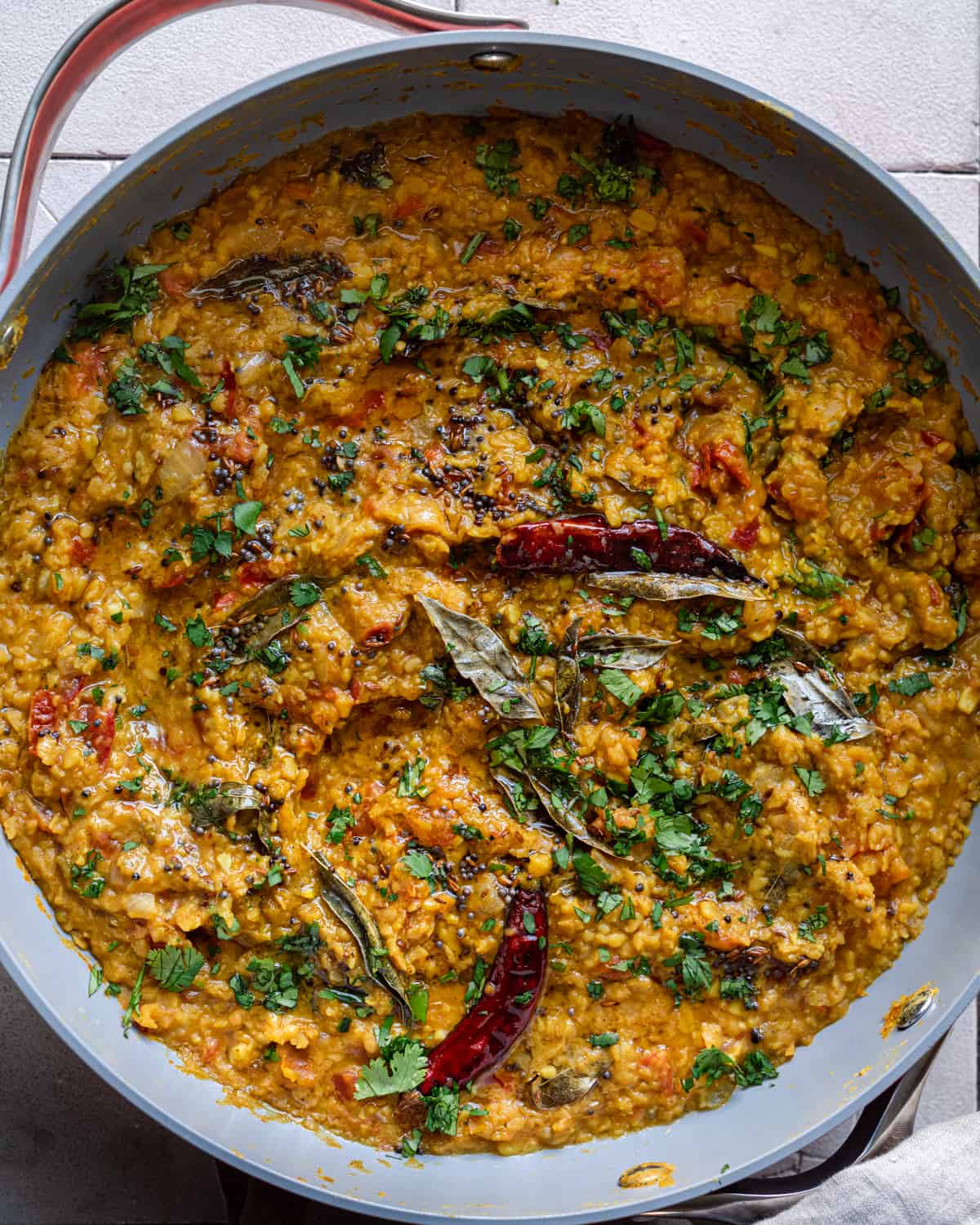
How to make this recipe in the Instant Pot
If you have an Instant Pot, I recommend making dal in the Instant Pot (less hands on cooking and you get a more unctuous consistency).
Reminder: I have an easy dal tadka recipe in my cookbook!
Step 1: Heat the oil in the Instant Pot using the Saute setting (medium heat). Once hot, add the onions and cook until softened. Add the ginger, garlic, green chili and cook for another minute.
Step 2: Add the ground spices for 30 seconds, stirring constantly. Add water as needed if the mixture dries out.
Step 3: Deglaze the pan with the water (I use 2 3/4 cups or 660 mL water). Add the soaked and drained lentils, salt, black pepper, and the diced tomatoes (canned or fresh).
Step 4: Pressure cook at high pressure for 10 minutes. Allow a natural pressure release for 10 minutes.Step 5: Make the tadka on the stove, as indicated in the recipe. Pour the tadka over the finished dal. Finish with cilantro.
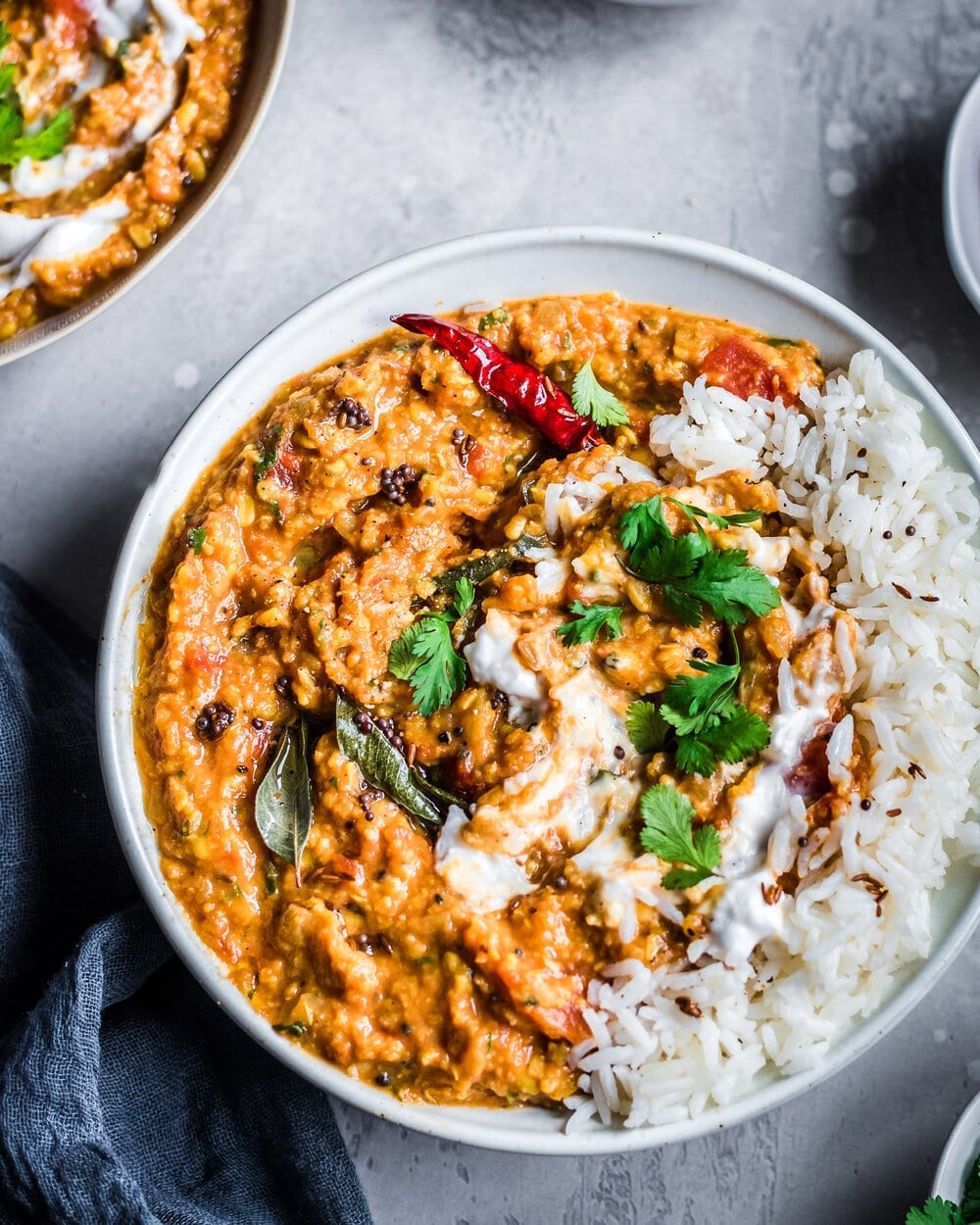
How to serve Dal Tadka
In most Indian families and restaurants, dal is served with either white rice or some sort of simple flatbread, like roti or chapati.
If you are feeling fancy, this dal pairs amazingly well with my homemade Vegan Naan recipe.
For toppings, I like to add a little coconut yogurt and thinly sliced red onion on top. If you don’t have vegan yogurt but still want something cooling, try a little diced avocado. Non-traditional but very good!
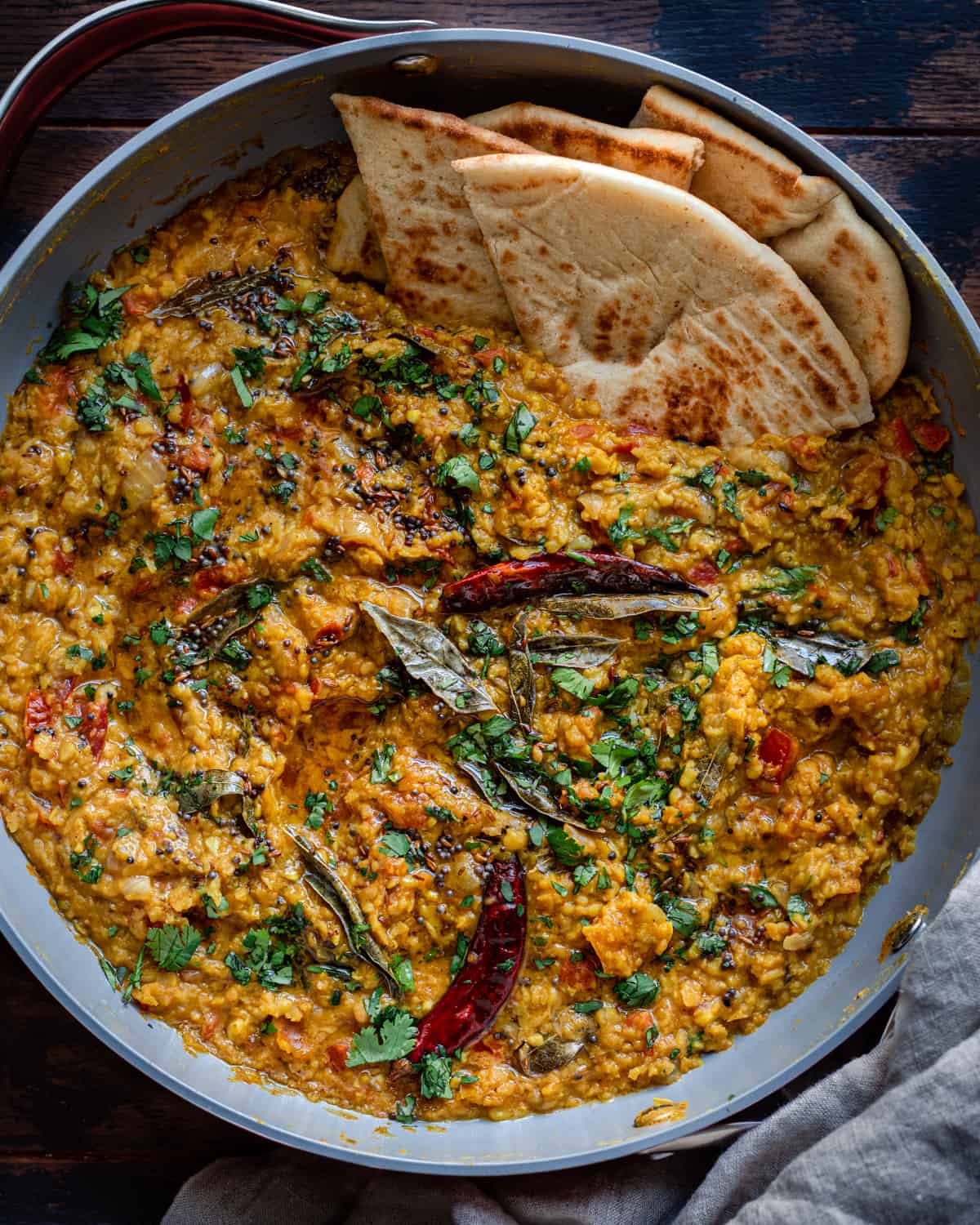
Watch! How to make Vegan Dal Tadka
In the above video, I show you how to make three different lentil recipes. For the Dal Tadka, fast forward to the 3:24 mark. And for more delicious recipe videos, check out my youtube channel!
If you love this recipe, be sure to tag me on Instagram with your recreations and please rate and review the recipe below!
Restaurant-Style Dal Tadka
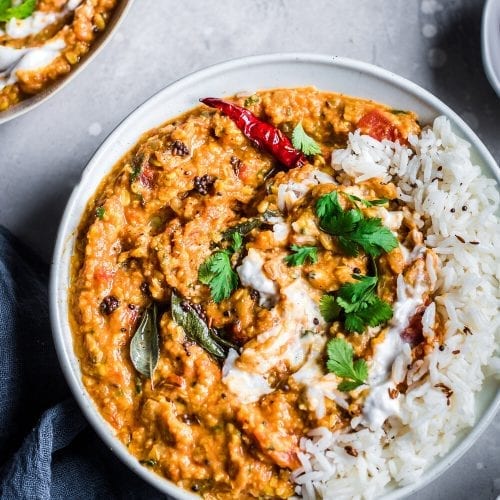
Ingredients
- 1 cup (200g) split yellow lentils, aka “moong dal”*
- 1 tablespoon coconut oil, or neutral oil of choice (more oil needed if not using a nonstick pan)
- 1 medium yellow onion, chopped
- 4 garlic cloves, minced
- 1- inch piece fresh ginger, grated or minced (about 1 tablespoon)
- 1 serrano pepper, diced (remove seeds & membranes for less heat)**
- 1 teaspoon curry powder
- 1 teaspoon garam masala
- 1/4 teaspoon ground coriander
- 1/4 teaspoon ground turmeric
- 2 1/2 – 3 1/2 cups (600 -840 mL) water***
- 1 teaspoon kosher salt, plus more to taste
- Black pepper to taste
- 1 (14.5-ounce / 410g) can diced tomatoes****
- 1 small handful of fresh cilantro, roughly chopped
Tadka
- 1 1/2 – 2 tablespoons coconut oil, or neutral oil of choice
- 1 teaspoon black mustard seeds, can substitute brown mustard seeds
- 1/2 teaspoon cumin seeds
- 5 to 10 fresh curry leaves (10 to 15 dried curry leaves)
- 1-2 dried red chile peppers (optional)
- 1 or 2 pinches asafetida (aka "hing") (optional)
Serving Options
- white basmati rice or Indian flatbread
- vegan coconut yogurt
- fresh cilantro and thinly sliced red onions
Instructions
Directions (Stove-Top)
- Sift through the lentils and remove any pebbles. Soak the lentils in cold water for 15 minutes and then drain them.
- Heat the coconut oil in a heavy, deep frying pan over medium-high heat. Once the oil is shimmering, add the onions and season with a pinch of salt, and cook for 5 to 7 minutes, until softened and starting to turn golden brown on the edges.
- Add the garlic, ginger and serrano pepper. Cook for 60-90 seconds, or until garlic is lightly browned and the mixture is very fragrant. Add the curry powder, garam masala, coriander, and turmeric and stir to coat into the onions, and cook for about 30 seconds, stirring almost constantly.
- Deglaze the pan with the water (I use about 2 cups at this stage), scraping up any browned bits on the bottom of the pan. Add the soaked and drained lentils, 1 teaspoon kosher salt, and black pepper to taste. Stir to combine.
- Bring the dal to a boil. Then lower the heat and partially cover the pan with a lid (if your lid has a small hole on top to allow steam to escape, you can fully cover the pan). Simmer the dal for 30 minutes, or until the lentils are fully cooked through, stirring occasionally and adding more water as needed to add adequate moisture/liquid to the dal.NOTE: Depending on your lentil variety, the cook time might vary from 25 to 35 minutes.
- Add the diced tomatoes and cook for 4-5 minutes, or until they’ve cooked down and are basically blended into the dal. If using fresh tomatoes, cook them until soft and broken down (fresh needs more time than canned). NOTE: If you want the dal to be thicker/creamier, run an immersion blender through some of the dal, but keep some lentils whole. It will also thicken more upon resting. Finally, stir in the chopped cilantro. Taste, adding more salt as needed.
- When the dal is done, make the tadka. Heat a small frying pan or tempering pan over medium heat on the stove. Add the 1 1/2 – 2 tablespoons of the coconut oil and, once it’s hot and shimmering, add the mustard seeds. Once the mustard seeds start popping (30 to 60 seconds), add the cumin seeds for a few seconds. Finally, add the curry leaves, dried red chile peppers (if using) and asafetida (if using). Keep stirring or shaking/swirling the pan to help cook the spices evenly and to prevent burning, 20 to 30 more seconds, or until very aromatic and the curry leaves have shriveled, the chili peppers and cumin seeds have turned darker. Remove from the heat immediately to prevent overcooking.
- Pour the tadka over the dal and stir to combine. If desired, garnish with additional fresh cilantro and taste for seasonings. Serve with white rice and other optional toppings, if desired.
Directions (Instant Pot)
- Sift through the lentils and remove any pebbles. Soak the lentils in cold water for 15 minutes and then drain them.
- Select the Sauté setting on the Instant Pot and let the pot heat up. Add 1 tablespoon of coconut oil or oil of choice, followed by the onion. Cook until the onion is translucent, 3 to 5 minutes.
- Add the garlic, ginger, and serrano pepper, and cook for 1 to 2 minutes, stirring frequently to prevent sticking. Add the Ground Spices and stir to coat into the onions, and cook for about 30 seconds, stirring almost constantly.
- Select the Cancel setting and pour in 2 3/4 cups water, using a wooden spoon to scrape up any browned bits on the bottom of the pot. Add the soaked and drained lentils, 1 teaspoon kosher salt, black pepper to taste, and tomatoes. Stir to combine.
- Secure the lid and set the Pressure Release to Sealing. Select the Pressure Cook setting at high pressure and set the cook time to 10 minutes.
- Once the 10-minute timer has completed, allow a natural pressure release for 10 minutes before manually releasing the steam. Stir the dal. It will thicken more upon resting. Taste, adding more salt as needed.
- While the dal is depressurizing, make the tadka. Heat a small frying pan or tempering pan over medium heat on the stove. Add the 1 1/2 – 2 tablespoons of the coconut oil and, once it’s hot and shimmering, add the mustard seeds. Once the mustard seeds start popping (30 to 60 seconds), add the cumin seeds for a few seconds. Finally, add the curry leaves, dried red chile peppers (if using) and asafetida (if using). Keep stirring or shaking/swirling the pan to help cook the spices evenly and to prevent burning, 20 to 30 more seconds, or until very aromatic and the curry leaves have shriveled, the chili peppers and cumin seeds have turned darker. Remove from the heat immediately to prevent overcooking.
- Pour the tadka over the dal and stir to combine. If desired, garnish with additional fresh cilantro and taste for seasonings. Serve with white rice and other optional toppings, if desired.
Notes





That was so amazing!
Rani, So glad to hear you loved this recipe!
Hello: Could I use cherry tomatoes here and if so, should I puree or chop them up small? Thank you.
Hi Alice, you can dice them by hand! Or pulse them in a food processor.
Thank you for all your amazing recipes. They are truly so delicious. I don’t use oil…do you have any thoughts on how to make the tadka without using oil? I have never had this dish before and really want to try it. I am guessing it’s not nearly as good without the tadka on top so I would really like to figure out a way to do this. Any thoughts? Thank you in advance
We’re glad you love them, MaryEllen! Tadka quite literally means “tempering spices in oil,” so you’re not going to get a very similar result as we did when recipe testing. With that said, our friend Vegan Richa has put together a full blog post titled “How to cook Indian food without oil & Oil-free Dal Tadka recipe” which you can read here. Hope that helped!
I know I’ve said it a few times before on your blog but you really never miss. :) thanks for all the amazing recipes.
Aw, thanks Kandi! We appreciate you!
I am so thankful I found you! I made this recipe the other night and it was AMAZING. I didn’t have fresh ginger or peppers on hand but used ginger powder and chili powder and it still turned out perfect. I traditionally have struggled with cooking but everything I’ve made of yours has made me feel like a skilled chef. Thank you so much. Cant wait to try more of your creations.
Hi McKenna, we’re thrilled to hear you enjoyed this recipe! Next time, would you mind leaving a rating alongside your review? Star ratings are big help to readers who are thinking of making the recipe. Thanks!
Is mung bean sold in Asian stores the same as moong dal? Thank you!
Hi there Amy, yes it is! Just make sure to pick up the “split” variety! Cheers :)
Can I use bay leaves instead of curry leaves?
Hi Amy, unfortunately not. Those two ingredients are quite different from one another. Sorry!
This recipe is delicious! I have made several of your recipes and they are all spectacular.
Thank you so much for sharing your talents and recipes with us to support our plant-based diet!
Sarah, So glad to hear you love the recipes!
As a uni student away from home who ate dal every few days growing up (we’re South African) your video about making this for your mom made me immediately tear up and miss my mom, miss home and miss dal! Thanks so much for helping me feel a bit closer to my family and our culture, the dal was delicious! I made it for my British boyfriend and he loved it too!
That’s so lovely to hear, Gabriela! Thanks for trying the recipe and sharing it with your boyfriend.
And we are so glad the recipe helped you feel closer to your family and culture, cheers!
A really rich and tangy dhal – simple to make and the tadka really boosts the flavour. Delicious!
That’s so great to hear, Melinda! Next time, would you mind leaving a rating alongside your review? Star ratings are big help to readers who are thinking of making the recipe. Thanks!
This was fantastic! And it was very fun to go to the Indian grocery store and pick up a few ingredients I hadn’t tried before!
Awesome, Marissa. Thanks for your comment and for taking the time to review!
This is the best dal recipe I’ve ever made. I turns out reliably good every time. I can’t tolerate onions so I replaced them with fennel and it is still incredibly delicious. I sometimes add a little coconut milk at the end for a creamier texture but it’s great without it too. Thanks Nisha for all the work you put into these fabulous recipes!
Jen, So glad to hear you loved this recipe!
I make this all. The. Time. My husband loves it too. Tonight I doubled the recipe and stocked my freezer with it too. The tadka as a finisher is a game changer. Seriously love this recipe !
Wonderful, Teresa! Thank you for sharing :)
I made this dish tonight with the exception of using Masoor dal instead of traditional yellow split peas and this is probably one of the best dals I have ever made. Dal is such a staple in my household but we generally make it a bit different excluding cilantro, tomatoes and ginger since regionally they’re not a part of our recipe. I will definitely be keeping this dal recipe in rotation. Thank you for taking the time to share.
Shoma, So glad to hear you loved this recipe!
So delicious, filling, and easy to make! Great for meal prep as well! Thank you :)
Thanks for sharing, Naomi!
I just made this recipe for lunch and it was amazing! So easy to pull together and it tasted so good. I always come to your website when I’m in the mood for vegan Indian cuisine. Always, always good. thanks!
Thanks for the lovely feedback, Mary!
You’re simply awesome… thank you for sharing all your tips and most of all your recipes 💚🙏🏽💚
Thanks for trying the recipes and for the lovely feedback, Roupa!
can I use curry paste instead of powder? I have red, green, and yellow curry pastes
Hi there, not really. Curry pastes are generally Thai and have Southeast Asian flavors (unless you’ve found Indian curry paste, though we’ve never seen that). They would make the dal taste a bit strange with the other Indian spices.
It sounds like the original poster is talking about Thai curry paste, but Indian curry paste is a thing. Patak’s makes several jarred pastes (in addition to sauces). Not sure if they are vegan, but they might work here. In any case, this recipe is awesome. I’ve made it with both red lentils and moong dal and both versions are delicious.
I’ve made this twice now and it’s the most delicious meal I’ve ever made!! Thank you, Nisha!
Awesome, Gina. Thanks for your comment and for taking the time to review!
Incredible!! The best dal I’ve ever made!! I thought I just would never be able to make anything close to what I have in restaurants but this is the real deal—in color, consistency, and of course, taste!
I could tell this recipe would be great, so I made a double batch and I’m so glad I did. For those thinking about doing so, I used the Instant Pot and accidentally let the naturally release go on for 17 minutes, but followed all other cooking instructions.
Thanks for the lovely feedback, Tyler!
This is soooo delicious! I am not vegan so used ghee but otherwise followed the IP recipe and the results are great. I am currently eating a portion I froze with white basmati rice and it’s perfect.
So glad you loved the Dal, Christine!